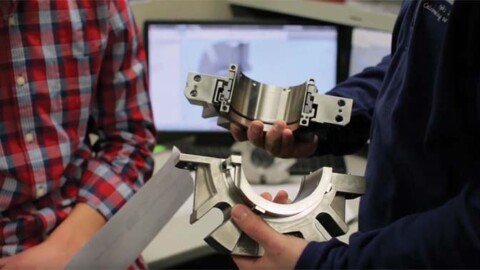The VNB series can monitor up to 500mm/sec at low frequency and will read RMS Velocity, the instruments will also monitor from 2Hz up to 1000Hz in this range and with Peak Acceleration or Acceleration RMS from 10 to 6000Hz.
The VNB provides real-time vibration monitoring via a meaningful local display along with various analogue and alarm output configurations. The VNB achieves this through a Tricolour Traffic light four digit LED display. Status LEDs also are included to show units used and output states.
Some important settings such as setpoints can also be set via two on board buttons. More importantly, the sensor can now be completely configured with the VES004 Diagnostic software which is easier and quicker and gives a whole gambit of extra features.
The VNB series can be used to protect and monitor against the following faults:
- Unbalance
- Misalignment
- Looseness of couplings and foot bolts
- Impacts
- General excessive vibration
Although not designed to pick up specific bearing faults which is achieved through other products in ifms’ range, there is an excellent chance that late stage bearing wear will be detected with the ‘A- Peak’ function.
This algorithm will also detect impacting type signatures, this can also be determined by the full time waveform, again an unusual feature on such a small sensor, that can be viewed and saved by the software.
Most vibration transmitters of this ilk give hard outputs only, so information can be somewhat lacking in relation to vibration levels if you are not in a position to see a SCADA or HMI screen. The VNB211 gives clear, concise information about the vibration that it is currently monitoring.
Additionally, the VNB211, with the inclusion of a specially designed splitter cable, can accept another especially designed accelerometer called VNA001. This accelerometer can also monitor its own two diagnosis’ so the whole system could be employed to monitor the drive and non drive end of a large direct mount fan for example, or two separate devices.
By using the same splitter cable, the VNB may also monitor another discipline, such as temperature or even a pressure transmitter by means of an external 4-20mA input which can be fed into the VNB. This can be scaled to show the status of the channel and setpoints can be programmed and used in conjunction with the vibration setpoints in a logical or gate fashion. In this way, either a vibration or temperature/pressure setpoints can trigger the alarm points.
Most units do not have an inbuilt display as intuitive as this one.
- Green when normal
- Yellow when in Pre-Alarm
- Red when in Alarm
- Yellow warning level output Led
- Red Damage Level output Led
All reading in real engineering units that can be altered from the programmed in units by pressing the ‘Set’ button on the unit to toggle the display.
Of course, the software also shows a comprehensive status screen when connected to the sensor. Using MEMS (Micro Electro Mechanical System) technology the sensor can be checked at any time
for correct operation using the TEST parameter which self-checks the vibration element, which is not available with IEPE.
The VNB211 also has another very unique feature. Inbuilt into the unit is a real-time data logger that, at default, stores the maximum vibration level every five minutes. The unit has a capacity of up to three years log time after which it will overwrite data (FIFO). This rate can be changed down to as little as one second intervals, which could make the sensor usable as a data-taker instrument in some instances.
The trends highlighted by this method show an enormous amount of very useful information which can give advance warning to many problems. To utilise this feature, an inexpensive data download cable (E30136) must be purchased which comes with a small USB driver that must be downloaded program from ifms’ website.
This History file can then be read through the use of ifm’s Vibration System Software Octavis VES004. This can be downloaded free of charge from ifms’ home page from the ‘Service/Download’ section by registering online.
A further function of the VNB211 is that it can be used as a mobile unit when the USB cable is connected. This powers the unit up so that the local display can be read and also the data logging function has full operation. It is currently available as a starter kit which represents hundreds of dollars in savings.
The power supply can be as simple as your phone charger or a battery USB supply it does not need not be a PC but of course when connected to a PC all settings, monitoring, downloads and exports
can be effected.
In this mode the output functions are disabled which is indicated on the display in red text (r5c3). This is a normal function of the device when data is being taken.
The VNB211 is also able to monitor and record full Time Waveform Raw data files which can be transformed into full spectra with the click of a button. This makes for a very powerful testing tool, it can even be magnetically coupled to perform highest amplitude quick measurements without the settling times or thermal issues found in IEPE sensors.
In addition to monitoring vibration the VNB211 can be setup to read an additional 4-20mA device, for example, a temperature transmitter. This transmitter can be scaled up within the parameters of the device to give one or two set points – in this way vibration from the amplifier and temperature from the external amplifier can be simply monitored using the same outputs so either an excess of vibration or temperature will alarm the unit. The external transmitter can also be read locally at the push of a button.
ifm has been engineering quality equipment for around 50 years now and has continually come up with unique and innovative sensors for industry in many different disciplines. ifm has come a long way from its infancy initially with the first electronic proximity switches and now with the release of very clever instruments for flow, level, temperature, vibration, position and control.
This partner content was brought to you by ifm. for more information please visit www.ifm.com/au.

















